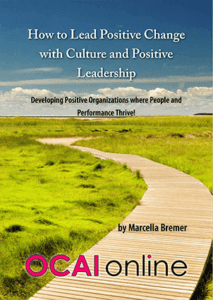Does your organization need to change? The answer might be yes. In my opinion, many organizations need to upgrade to the 21st century and become positive organizations where people and performance thrive.
But it’s not just my opinion. It’s a matter of fact – the market rewards organizations that are agile, with a competency to change, and that are innovative as well as customer-friendly and competitive. Another fact is that many employees are disengaged – and that when people quit it’s because they want to leave their boss, the toxic culture, or the stifling hierarchy. They long for autonomy, mastery, and purpose as Daniel Pink described.
Change
So…. change may be necessary – whether you like it or not. The numbers below give an interesting view on current organizations:
13% of employees are engaged (Gallup) – so 87% is not (fully)!
96% say culture change is needed in their organizations (Strategy&)
32% say their culture aligns with strategy (Korn Ferry) – so 68% does not!
51% say they need a major culture change (Strategy&)
Well, okay then. Change might be needed at times. But if so, how? My experience to date underlines that it may be wise to use both culture and positive leadership if you want organizational change to succeed.
Organizational Culture
Why would you bother with Culture? If you don’t work with culture, it might work against your organizational change.
But isn’t culture a soft phenomenon? I sometimes see how technically or financially educated leaders perceive culture as an invisible hand – an influence they cannot see or have some grip on – hence can be neglected.
But culture can be a very hard hand that holds you firmly and that influences your organizational results – for better or worse. If you don’t influence culture – it will surely influence you.
In change projects, I always ask my clients: How are you and your behaviors part of the current culture? They often shrug, or tell me: As a leader, I’m not part of the regular employee culture. Well – you might be surprised.
You wonder why your organization is so bad at change? Is it because employees are too busy meeting their performance targets, that there is no time to change? And/or is it because you’re so attached to your habits of thinking and doing? How good are you at change? What do you embody?
You wonder why your organization isn’t more innovative? Is it because the competition is so technologically savvy that they are way ahead? Or is it because you’re not open to learning new, unexpected information and you’re quick to judge before you understand?
Wonder why your managers are complaining? Are they not fit for their jobs and would you be better off if you did everything yourself? Or is it because you don’t give others space to act, while you allow space for complaining? Complaining is a victim mindset and is the opposite of acting and solving issues…
Why are the turnover declining and customers less content? Is it the tough market and unreasonably demanding and opportunistic clients? And/or haven’t you listened to customers for a while?
Do you see what I mean? Culture is closely linked to leadership. Culture is reinforced by personal behaviors and interactions among people. The “invisible hand” that helps or hinders becomes visible when you learn to see group dynamics. How people copy you. How they copy each other. How they coach each other. And, if needed, correct each other to do it “the way we do things around here”.
That may be easier to see for executives educated in humanities, health care, education and other “people-oriented” fields. But as we’re all people – any executive can learn to see the culture and work with it.
 To learn more about culture and successful change, you can download my new Ebook “How to Lead Positive Change with Culture and Positive Leadership”.
To learn more about culture and successful change, you can download my new Ebook “How to Lead Positive Change with Culture and Positive Leadership”.
If you’re a member, log into your account to download it.
If you just want the eBook and nothing else – get you copy here.
Positive Leadership
Next, why would you bother with Positive Leadership? The research evidence is clear: Positive Leadership makes a difference in productivity and happiness at work. It becomes easier to trust and to open up and change.
It will help people open up to change and perform way better than when they’re controlled, limited, scared, belittled, etc. The last thing you need during organizational change is fear, accusations, people not feeling safe and closing themselves off. You can do without the negative projections from the past: “Things never work around here, and managers are out to get you.”
What you do want is people to see the positive possibilities of the change, the untapped future potential – and to achieve even more than they’d expected when they started the change.
You can’t afford to not know about Positive Leadership, and wherever possible, apply it. Your organization depends on it.
I invite you to be the one who knows how to facilitate the necessary change by working with culture instead of against it. I hope you’ll be a positive leader who engages the others. Our workplaces need positive leaders who entice the other 87% to fully engage and contribute their potential.
Read more about the eBook here.
Marcella Bremer is an author and culture & change consultant. She co-founded this blog and ocai-online.com.
